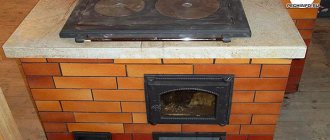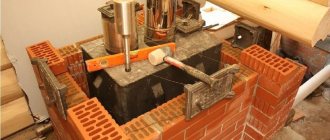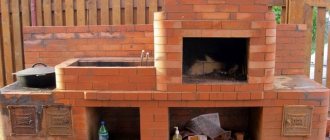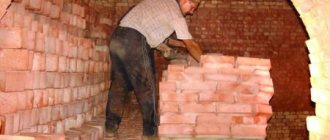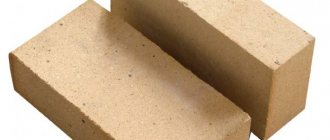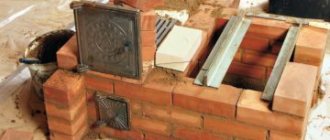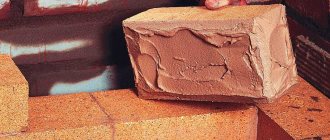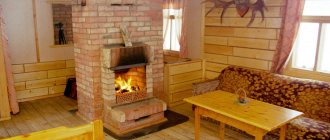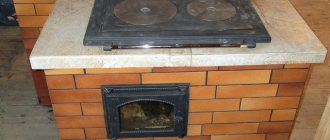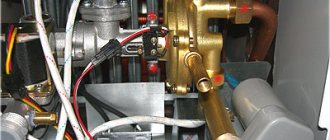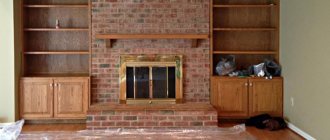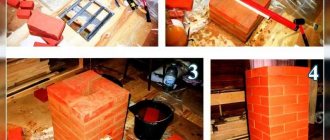Before answering the main question - is fireclay brick harmful, it is necessary to understand what kind of building material it is, in which areas and structures it is used and from which components it is produced.
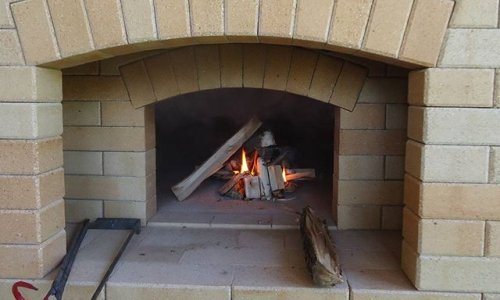
Most often, fireclay bricks are used in the construction of stoves and fireplaces.
Conventional bricks used in construction are not suitable for structures that are constantly exposed to high temperatures. For such conditions, bricks from refractory materials are used, the most popular of which is fireclay bricks. It is difficult to imagine both private and industrial construction without its use.
Characteristics affecting quality
The following properties of the product must be taken into account:
- thermal conductivity - is the ability to transfer heat received from indoor air to the outside;
- heat capacity - the amount of heat that allows one kilogram of building material to be heated by one degree Celsius;
- density - determined by the presence of internal pores.
Below will be a description of the different types of products.
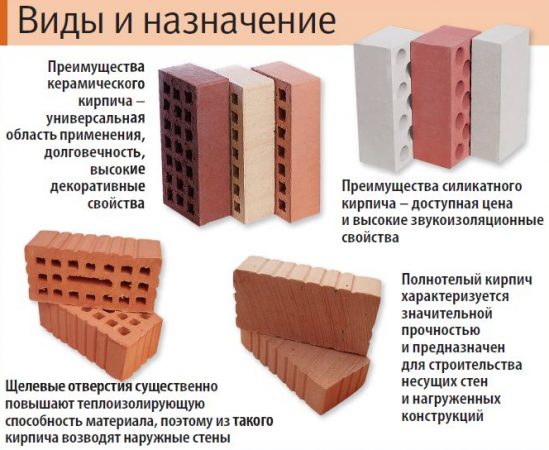

Types of bricks
Ceramic
They are made from clay with the addition of certain substances. After manufacturing, they are heat treated in specialized ovens. The specific heat index is 0.7–0.9 kJ, and the density is about 1300–1500 kg / m3.
Today, many manufacturers produce ceramic products. Such products differ not only in size, but also in their properties. For example, the thermal conductivity of a ceramic block is much lower than that of a conventional block. This is achieved due to the large number of voids inside. There is air in the voids, which does not conduct heat well.
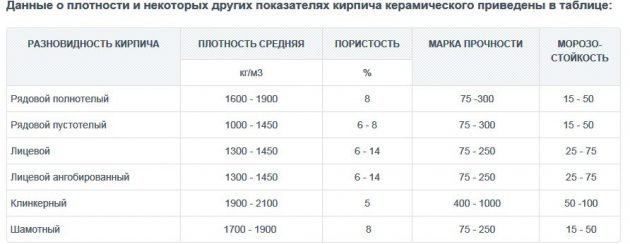

Properties of ceramic bricks
Furnace equipment
During the laying of the rows of the furnace, the necessary equipment is immediately mounted. These are doors, grates, hobs. All of them are made of cast iron, but it is imperative to observe the gap, otherwise the cast iron will simply break the already laid brick during operation. The grates are installed without mortar, the gap is maintained at 5 mm. The cleaning grate must be easy to remove and under no circumstances should it be flooded with solution.
There are several types of doors - furnace, cleaning, blowing. When installing them, you must use a wire. It is imperative to check the correct installation so that the door is not skewed. For fastening the doors, there are special holes through which wire bundles are inserted. A cast iron hob is only installed if the oven is of the appropriate design.
Today, manufacturers offer numerous options for materials for laying stoves, including fireclay bricks. But its cost is high, the construction of a furnace entirely from chamotte is not advisable. It is better to make a construction of red oven bricks, and use fireclay bricks for the furnace compartment.
Silicate
Silicate bricks are in high demand in construction, their popularity is due to their strength, availability and low cost. The specific heat index is 0.75 - 0.85 kJ, and its density is from 1000 to 2200 kg / m3.
The product has good sound insulation properties. A wall made of silicate products will insulate the structure from the penetration of various kinds of noise. It is most often used for the construction of partitions. The product is widely used as an intermediate layer in masonry, which acts as a sound insulator.
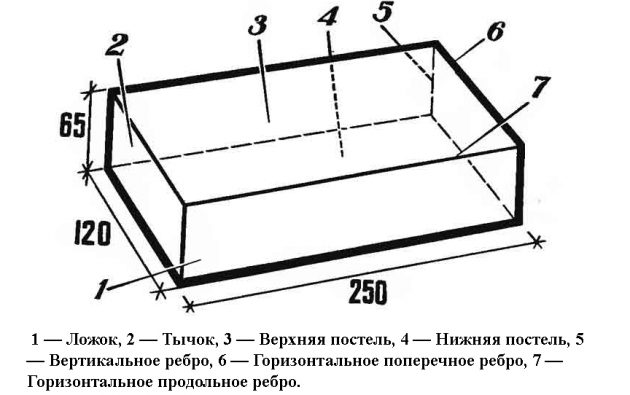

Silicate brick scheme
How to fold the furnace firebox with your own hands
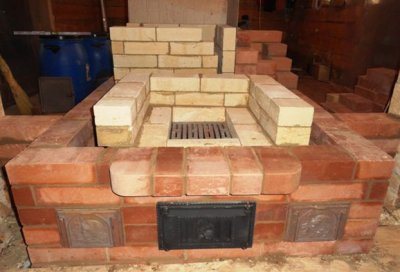

The furnace firebox consists of blowing (ash pan) with a door, grate and combustion chamber (firebox) with a door.
Dimensions (edit) are determined based on the volume of firewood for simultaneous loading. The width of the combustion chamber is equal to its door or slightly wider on both sides.
Height the firebox should facilitate complete combustion of the fuel, which is achieved by the presence of free space in the chamber after loading the firewood. Recommended height 80-100 cm.
Reference. The depth of the furnace must be able to accommodate the length of the combustible material, there are no other restrictions.
The combustion chamber is connected to the ash pan by means of a grate... The latter is designed to supply air during combustion and collect ash. When installing the grate, it is necessary to deepen it below the level of the furnace door in order to prevent burning coals from falling onto the floor.
The firebox must have bevels in the direction of the grate to move the ash into the ashtray. Gap between masonry and grate it should be not less than 5 mmto prevent the brick from bursting as a result of the difference in the expansion of the brick material and the metal at high temperatures.
The choice of materials for masonry and floors, than to process the structure
The structure is manufactured from clay red bricks with cladding (lining) refractory material. When choosing a brick material, you must pay attention to the fact that it is not burnt or cracked. High-quality bricks suitable for stove masonry have smooth edges, sharp edges and a uniform color, a clear, almost metallic sound is heard when tapped.
Attention! Silicate brick is not suitable for the construction of the device.
The following materials will be required:
- Red brick - for walls;
- refractory and wedge-shaped (fireclay) bricks - for lining and overlap formation;
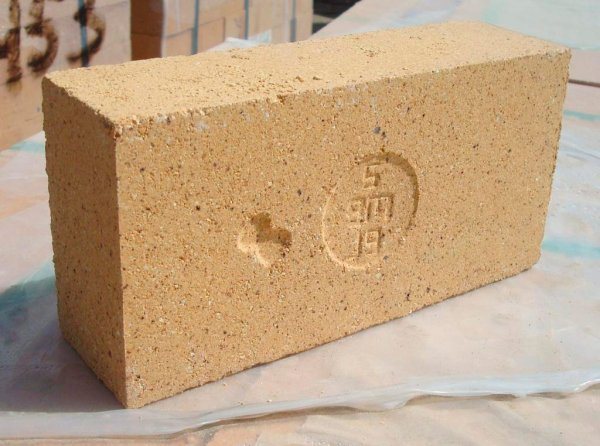

Photo 1. Refractory bricks used for laying the furnace firebox. Before using the material, you must ensure its integrity.
- clay, sand, water - for the solution;
- cast iron grate;
- doors combustion chamber and blower;
- steel strips or wires - for fastening the doors;
- asbestos sheet - for a fireproof gasket between masonry and doors.
For joining oven masonry you can buy a ready-made mixture or prepare the solution yourself. In the high temperature zone, compositions are used exclusively from red clay, sand and clean water. The quality of the solution depends on the viscosity, plasticity and fat content of the clay. The sand for the building must be free of dirt and impurities.
Instrument preparation
Making a structure with your own hands will allow required set of tools:
- oven hammer;
- Master OK - for applying the solution;
- large capacity - for solution preparation;
- building level - to control the correctness of the masonry;
- measuring instruments - ruler, tape measure, square;
- plumb lines - to define the outer contour.
How to properly cover the firebox and make the roof of a brick oven
For the construction of the firebox, it must be determined exact diagram the future furnace and laid foundation with a layer of waterproofing.
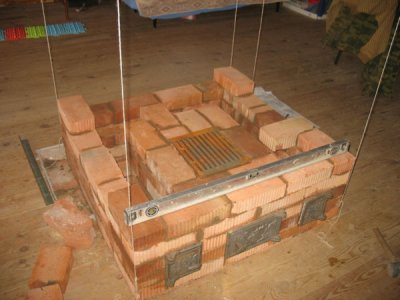

Before laying on the mortar, you need to assemble the structure without it - for accurate adjustment of the bricks to size.
The construction looks like this in stages:
- Prepare a solution.
- First row laid on the foundation without gaps and formed under the furnace.
- On the second row the formation of the ash pan and the fastening of its door begin. To do this, mark the center of the future firebox and place the blower strictly under it. A flexible wire is passed through the holes in the door frame and its ends are twisted with a bundle. Wire harnesses are fixed in the masonry layer.
- Form the outline blower and the place of laying the grate.
- Fix the fire door with a wire. The door frame is insulated with a non-flammable gasket.
- Form the walls a firebox and a vault with a hole for connecting a chimney.
- Carry out lining the combustion chamber with refractory bricks.
Important! When building you can not bandage simple brick and fireproof due to the different expansion coefficient. When heated, such masonry will burst.
Facing
Cladding blocks are widely used in the decoration of external walls of buildings, not only because of their attractive appearance. The specific heat capacity of a brick is 900 J, and the density value is within 2700 kg / m3. This value makes it possible for the material to resist well the penetration of moisture through the masonry.
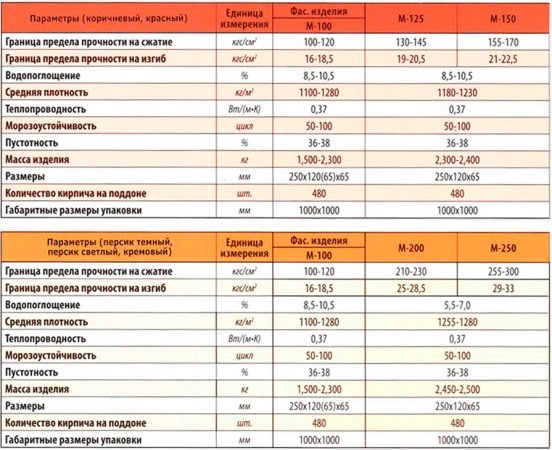

Characteristics of facing bricks
Characteristics of fireclay bricks
Important! The main characteristics of fireclay refractory bricks are reflected in the State Standards for products of this type, however, in some cases, the manufacturer can regulate the characteristics of the product with the Technical Specifications of the departmental or in-plant level.
Density
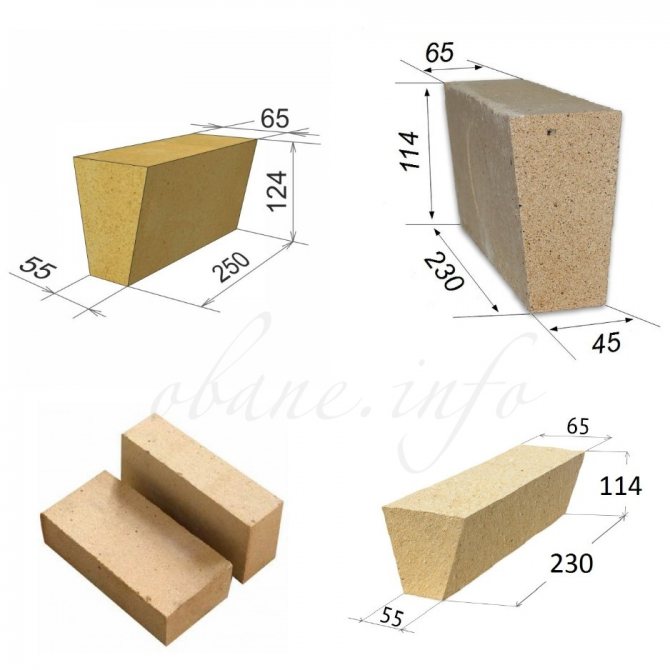

The density of this material ranges from 1700 to 1900 kg / m3. It should be understood that the higher the specific gravity of the material, the greater its heat capacity, and at the same time, as a rule, it is mechanically more durable. The latter circumstance also has a negative quality, in the sense that high-strength material is difficult to process to give it certain geometric shapes and sizes when fitting in the oven masonry.
Fire resistance
Standard fire resistance ranges from 1100 to 1800 degrees Celsius. Moreover, for the operating conditions of the sauna stove, an indicator of 1400 degrees is quite enough.
Strength
The grade of mechanical strength is within the range of M 75 - M 250. As mentioned above, the machinability of the material directly depends on the indicator of the mechanical strength, in order to give it a certain size or shape.
It will be useful to give an information table that reflects the weight of fireclay bricks, pre-packed on a standard wooden pallet:
| Name of product | Linear dimensions of one product, in mm | Number of bricks in a pallet, pcs | Gross weight of one pallet, t |
| Straight brick, grade ШБ - 5 | 230×114×65 | 385 | 1,309 |
| Straight brick, grade ШБ - 8 | 250×124×65 | 297 | 1,188 |
| Ledger brick, grade ШБ - 6 | 230×114×40 | 630 | 1,350 |
| Wedge end brick, grade ШБ - 22 | 230×114×65×55 | 420 | 1,302 |
| Wedge end brick, grade ШБ - 23 | 230×114×65×45 | 420 | 1,218 |
| Wedge ribbed brick, brand ШБ - 44 | 230×114×65×55 | 420 | 1,302 |
| Wedge ribbed brick, | 230×114×65×45 | 420 | 1,176 |
| grades ШБ - 45 Fireclay slabs, grades ШБ - 94 | 460×230×75 | 84 | 1,367 |
Furnace refractory plates are also widely used in the formation of their hot parts and allow the formation of planes with one element.
Frost resistance brand
This indicator characterizes the ability of a material to withstand a certain number of cycles of exposure to negative temperatures without signs of permanent deformation or destruction. In the conditions of periodic use of a country bath, this is an important objective indicator that determines the durability of the device.
Coefficient of thermal conductivity
The specified parameter defines. How quickly and efficiently the furnace will heat up and how much heat energy the material will radiate into the surrounding space. Characteristically, fireclay bricks of various brands have approximately the same coefficient of thermal conductivity, which fluctuates within 0.6 W / m C.
Refractory
Refractory blocks can be divided into several types:
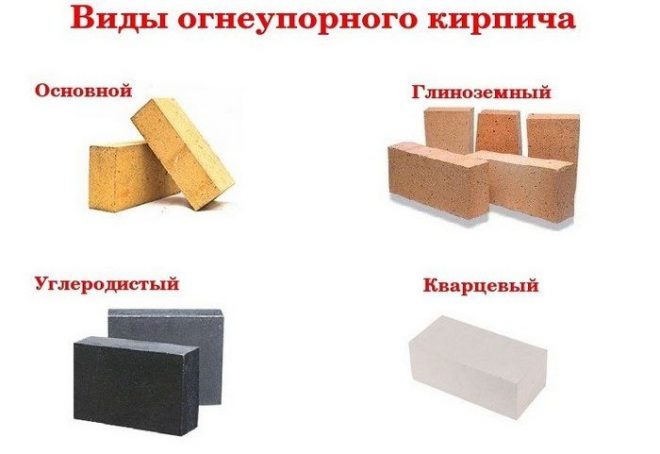

Types of refractory bricks
- carborundum;
- magnesite;
- dinas;
- fireclay.
Fire-resistant products are used for the construction of high-temperature furnaces. Their density is 2700 kg / m3. The heat capacity of each type depends on the manufacturing conditions. Thus, the heat capacity index of a carborundum brick at a temperature of 1000 ° C is 780 J. Fireclay brick at a temperature of 100 ° C has an index of 840 J, and at 1500 ° C this parameter will increase to 1.25 kJ.
Masonry mortar
The mortar for masonry must be taken from clay, ordinary cement in this case is completely inappropriate. Before preparing the clay, you need to soak, wash and sift the sand. It is necessary to take only the river, no lumps and the content of silt in it is not allowed. Fraction is recommended 1-1.5 mm. During the preparation of masonry mortar, a ratio of 1: 2 or 3: 2 parts of sand to clay is observed.
There are several methods for making high quality clay masonry mortar:
A fireclay brick stove will last for many years, since the material is not subject to destruction during temperature extremes.
A solution is kneaded from the previously soaked clay and sand, then a ball with a diameter of 5 cm is formed. Then you need to lay it on a wooden board, and then squeeze it with a second board. If the clay crumbles, then the solution is of poor quality, it cannot be used. If the cracks take up 1/3 of the volume, then the mortar is excellent for laying the stove. If the cracks occupy half of the volume, then you need to add sand, and then check the ductility again.
Influence of temperature conditions
The quality is greatly influenced by the temperature regime. So, with an average density of the material, the heat capacity may differ, depending on the ambient temperature.
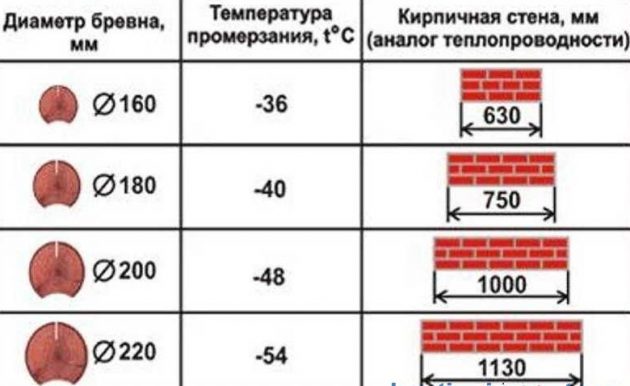

Comparison table of thermal conductivity of logs with brickwork
From the above, it follows that it is necessary to select a building material based on its characteristics and its further field of application. So it will be possible to build a room that will meet the necessary requirements.
Related video: Types of bricks
Related publications
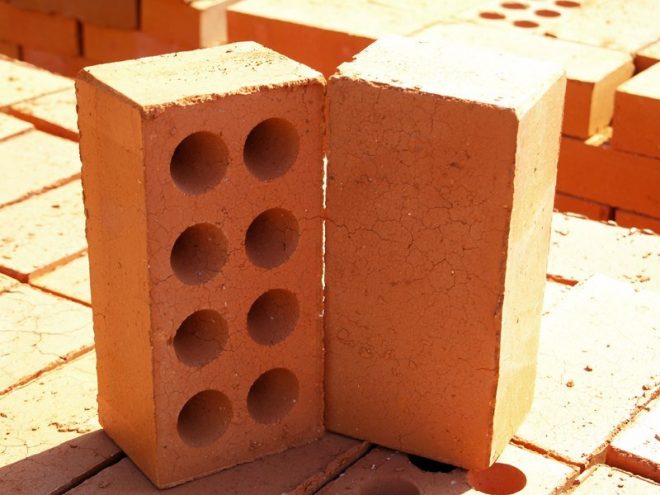

Pros and cons of ceramic bricks
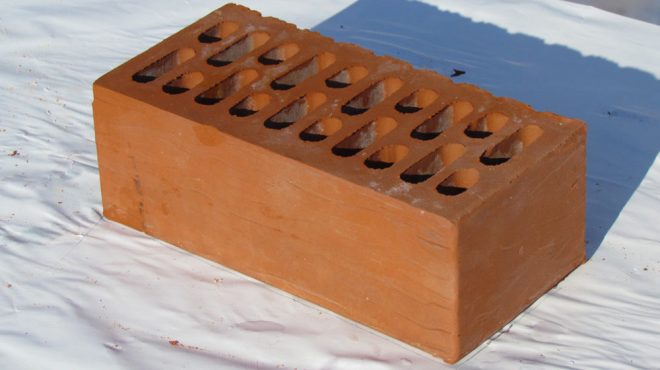

Standard sizes of one-and-a-half brick
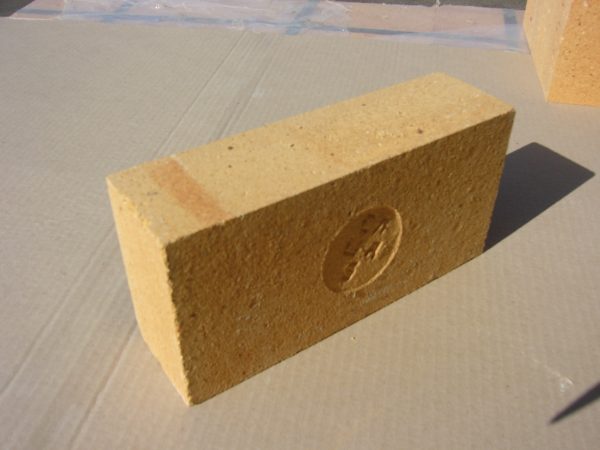

Varieties and area of application of fireclay bricks
disadvantages
Based on the foregoing, an unambiguous conclusion can be made - the myth about the harmfulness of fireclay bricks has no factual justification. Moreover, it is difficult even to simply explain the cause of its occurrence. It is possible that the material unwittingly "suffered" due to the fact that the very production of fireclay bricks, like most other building materials, especially before the advent of modern technology, was often not a role model for environmentalists.
Be that as it may, the experience of many years of operation of the material allows us to unequivocally assert that when exposed to high temperatures (even extremely high), absolutely no substances harmful to humans are released. It is difficult to expect otherwise, especially considering that in the production of fireclay bricks, a material is used, the ecological purity of which is difficult to doubt, namely clay. You can even draw a parallel with pottery, which has accompanied man for many hundreds of years.
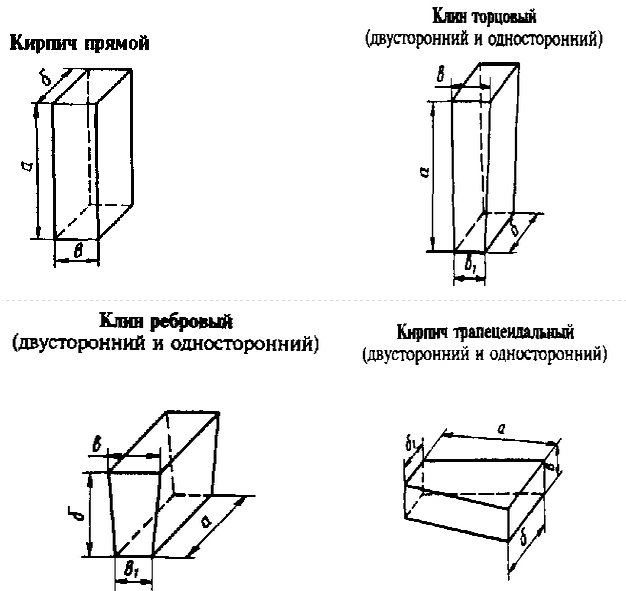

Possible forms of fireclay bricks.
Does this mean that fireclay bricks have no flaws? Of course not. Several main ones can be noted:
- Fireclay bricks are difficult to handle and cut due to their high strength. This minus is partially offset by the variety of shapes of fireclay bricks, which make it possible to achieve almost any design delights without cutting the material.
- Even in one batch of the product, deviations in the size of the bricks are noticeable, and it is problematic to achieve greater unification of the blocks due to the peculiarities of the production technology.
- The high cost of the material in comparison with ordinary brick. It is also impossible to avoid this drawback: operating conditions require the use of a suitable material. The use of conventional, non-refractory bricks sharply reduces the service life of the structure or requires the use of additional means of processing it.

